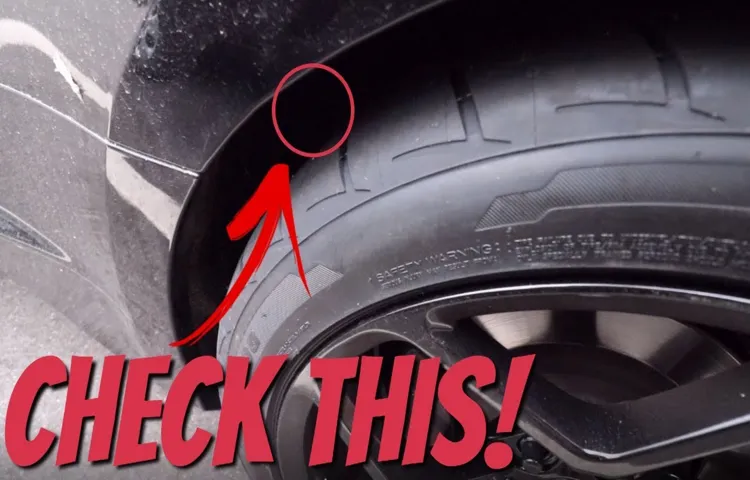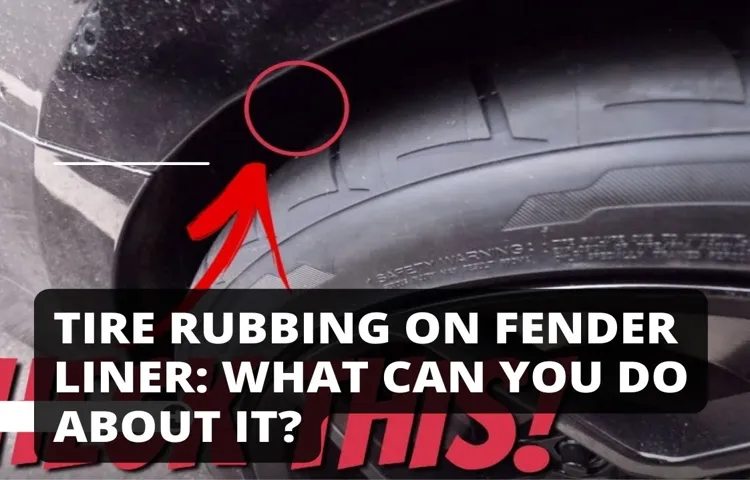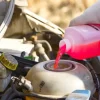Have you ever noticed an annoying noise coming from your car while driving? And worse, have you ever felt your car shaking or vibrating? If so, the issue may be tire rubbing on the inner fender. This is a common problem that can arise in any type of vehicle. Whether you are driving a sports car or an SUV, tire rubbing can cause significant damage to your vehicle, reduce its performance, and make your ride uncomfortable.
The reason why your tire is rubbing against the inner fender is usually due to an alignment issue. This means that the angle and position of your wheels are incorrect, resulting in the tire rubbing on the fender as you drive. Alternatively, it could be due to a suspension issue, such as worn-out shocks or springs, which can also cause misalignment.
If you don’t solve the problem of tire rubbing, it can lead to some major issues that can cause more damage to your vehicle. These issues include tire wear, abrasion on the fender, ruined shocks or suspension, and many more. This not only causes regular trips to the mechanic, but can also be expensive to fix.
Don’t let tire rubbing ruin your driving experience. If you’re experiencing this issue in your vehicle, it’s important to get it checked out by a professional mechanic. Fixing the alignment or suspension issue will not only make your driving experience smoother, but it’ll also prevent any further damage to your vehicle.
Table of Contents
Causes
Have you noticed a weird, scraping sound and felt a strange sensation when turning in your vehicle? This could be a sign of your tire rubbing on the inner fender. There are a few things that can cause this issue. First, it might be due to low tire pressure or worn-out suspension components, which can cause your tire to sag and rub against the fender.
Another possible culprit could be a damaged or warped fender liner, which is the protective cover that lines the inside of your vehicle’s fender. Additionally, if you have aftermarket wheels or tires that are too large for your vehicle, they may rub against the fender. Whatever the cause, it’s important to get this issue resolved quickly, as it can cause serious damage to your tire and fender if left unaddressed.
So, make sure to take your vehicle to a trusted mechanic to get it checked out as soon as possible.
Worn suspension parts
If you’ve experienced shaky rides, uneven tire wear, or a drifting vehicle, worn suspension parts could be the issue. Suspension parts work together to provide a smooth driving experience. However, due to regular use or harsh driving conditions, these parts can become worn and eventually fail.
The most common cause of worn suspension parts is age and regular wear and tear. Moreover, poorly maintained roads, accidents, and off-road driving can also contribute to the wear and tear of suspension parts. As these parts age and fail, they become less effective in their function, leading to a bumpy and unstable ride.
Replacement of these parts is vital for maintaining proper control of the vehicle and ensuring the safety of the driver and passengers. Therefore, if you notice any of the signs of worn suspension parts, such as creaking noises or reduced handling, it’s essential to bring your car to a professional mechanic right away. With proper maintenance, you can enjoy a safe and comfortable ride on the road ahead.

Incorrect tire size
Incorrect tire size can cause a variety of issues for drivers. It’s usually the result of a mistake made during the purchase or installation of new tires. If the tire size isn’t appropriate for the make and model of the vehicle, drivers may experience problems with their steering and handling, not to mention the safety concerns that come with driving on the wrong size tires.
One of the most common issues that arise from incorrect tire size is a loss of control on the road, which can lead to accidents and other hazards. Other potential problems include an increased risk of blowouts, reduced fuel efficiency, and premature tire wear. To avoid these issues, it’s essential to ensure that you’re purchasing the correct tire size for your vehicle, or consulting with a professional mechanic to make sure that the tires you’re using are appropriate for your vehicle and the driving conditions you encounter.
Incorrect wheel offset
When it comes to wheels, getting the right offset is crucial to keeping your vehicle running smoothly. An incorrect wheel offset can cause a variety of issues, from reduced performance and steering problems to increased tire wear and potential damage to your suspension system. So, what causes an incorrect wheel offset? One common cause is purchasing aftermarket wheels that have an offset that doesn’t match your vehicle’s factory specs.
Another issue can arise if you change the width of your wheels without adjusting the offset, leading to improper placement on your vehicle’s hub. Additionally, if your wheels are damaged or bent, they may have an incorrect offset that can cause problems. No matter the cause, it’s important to address any issues with your wheel offset quickly to avoid potential safety hazards on the road.
Symptoms
Have you ever noticed a strange noise or sensation when turning your vehicle? If you’ve noticed a tire rubbing on the inner fender, then it’s definitely time to take action. This issue can be caused by a number of things, including worn-out suspension components, incorrect wheel alignment, damaged wheels, or oversized tires. One of the most tell-tale signs that your tire is rubbing on the inner fender is when you hear a squeaking or grinding noise.
In some cases, you may even feel a vibration through the steering wheel or the driver’s seat. If this problem is not addressed promptly, it could lead to serious damage to your tires and/or suspension, which can be expensive to fix. It’s important to have your vehicle inspected by a qualified mechanic to determine the root cause of the problem and get it fixed right away.
Rubbing sound when turning
If you hear a rubbing sound when turning your car, it’s important to address the issue right away. One common cause of this sound is worn brake pads. As you turn, the worn pads can come into contact with the rotor, producing a rubbing sound.
Another potential cause is a faulty wheel bearing. This can also produce a rubbing or grinding sound when turning. Additionally, a loose or worn steering or suspension component can cause the same sound.
It’s important to have a professional diagnose the issue, as driving with a faulty brake system or steering/suspension system can be dangerous. Stay safe on the road and have any unusual noises checked out promptly.
Loss of performance and handling
Symptoms of loss of performance and handling in a vehicle can vary from noticeable changes in acceleration and braking to a general feeling of instability on the road. You might experience difficulty in keeping control when driving on uneven surfaces or feel a sudden decrease in power when attempting to accelerate. These symptoms may be accompanied by strange noises or vibrations, or even a popping or clunking sound when turning or going over bumps.
It’s crucial to address these issues right away, as loss of performance and handling can not only affect your driving experience but also compromise your safety on the road. Regular maintenance and inspection can help you identify and address any underlying problems before they become more severe. Don’t wait until it’s too late, keep your vehicle in optimal condition for a safe and smooth ride.
Solutions
If you’re experiencing tire rubbing on your inner fender when turning, there are a few solutions to consider. One of the most common causes of tire rubbing is having tires that are too large for your vehicle. In this case, downsizing to a smaller size may be your best bet.
Another option is to adjust your wheel offset or backspacing, which can help push the tire away from the inner fender. Some drivers also choose to install wheel spacers or aftermarket fender flares to create more clearance. It’s important to note that tire rubbing can cause damage to both your tires and fenders, so it’s best to address the issue sooner rather than later.
Checking your tire pressure, alignment, and suspension components can also help prevent rubbing and ensure your vehicle is operating at its best.
Inspect and replace worn suspension parts
If you’re experiencing a bumpy ride or hear strange noises coming from your wheels, it may be time to inspect and replace your suspension parts. Worn suspension parts can negatively impact your vehicle’s handling, ride comfort, and even its safety. To identify which parts need to be replaced, take a look at your springs, shocks, struts, and bushings.
Often, these parts wear out over time due to regular use and exposure to various elements. Replacing them can improve your vehicle’s ride quality and restore its handling to its original condition. It’s important to have your suspension inspected regularly, especially if you frequently drive on rough terrain or have an older vehicle.
By doing so, you’ll catch any potential issues before they become major problems. Don’t hesitate to take your vehicle to a trusted mechanic to get a professional opinion. They can help you identify which parts need replacing and ensure that the job is done right.
Keep your suspension in top condition to ensure a smooth ride on the road.
Install correct tire size and wheel offset
Installing the correct tire size and wheel offset can significantly improve your driving experience. It’s essential to ensure that your tires are the right size to maintain proper handling and stability on the road. Using the wrong size can lead to poor performance, increased wear and tear, and decreased safety.
Additionally, wheel offset plays a crucial role in determining the distance between the wheel and the car’s suspension. The incorrect wheel offset can cause rubbing against your car’s suspension, causing damage to both the tire and the vehicle. Thankfully, solutions exist to make sure you have the right tire size and wheel offset.
Consult your car’s owner manual, visit a reputable tire and wheel shop, or use an online fitment guide to determine the best size and offset for your vehicle. By investing in the correct size and offset, you’ll improve your car’s handling, increase its efficiency, and maintain its overall health.
Adjust suspension for desired performance
When it comes to improving the performance of your ride, adjusting the suspension can make a significant difference. Depending on your desired outcome, lowering or raising the suspension can have a direct impact on how your car handles on the road. For example, if you’re wanting to take turns at higher speeds, a stiffer suspension may be necessary to reduce body roll and improve overall stability.
On the other hand, if you’re looking for a smoother ride, you may want to consider softer suspension settings. It’s also important to note that changing the suspension settings can affect the height of your car, so be mindful of any adjustments that may affect ground clearance. Overall, fine-tuning your suspension to fit your driving style and preferences can greatly enhance the handling and performance of your vehicle, making it a worthwhile upgrade for those looking to take their driving experience to the next level.
Conclusion
If your tire is rubbing on the inner fender when turning, it’s a clear sign that your car is feeling a little too clingy. Maybe it’s time to remind your vehicle that some space is healthy for any relationship. Or, you know, you could just check your tire pressure and alignment.
“
FAQs
Why is my tire rubbing against the inner fender when I turn?
There could be multiple reasons for this, such as worn out suspension components, improper wheel alignment, or oversized tires that don’t fit the vehicle properly.
Is it dangerous to drive with a tire rubbing on the inner fender?
Yes, it is dangerous as it can cause the tire to wear out unevenly, create excessive heat buildup, and even lead to a tire blowout while driving.
Can I fix a tire rubbing issue myself?
It depends on the root cause of the issue. If it’s due to an alignment or tire size issue, it’s best to take it to a professional mechanic. However, if it’s due to a loose or worn out suspension component, it’s best to replace it immediately.
How can I tell if my tire is rubbing on the inner fender?
You may hear a scraping or rubbing noise when you turn the steering wheel or go over bumps. You can also check for signs of wear on the inside of the tire or inner fender.
What is the estimated cost of repairing a tire rubbing issue?
The cost can vary widely depending on the underlying issue. It could be a simple adjustment or require more complex repairs or even replacement of parts. Consult with a professional mechanic to get an accurate estimate.
Can a tire rubbing issue cause damage to other parts of my car?
Yes, it can cause damage to other parts of the car such as the suspension, body, and even the wheel hub. It’s important to address the issue as soon as possible to prevent potential damage.
What other symptoms might indicate a tire rubbing issue?
Other symptoms can include a bumpy or unstable ride, excessive tire wear, and vibrations in the steering wheel or vehicle.



